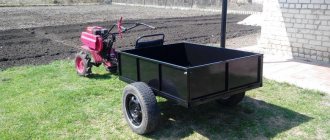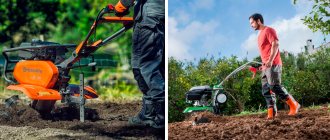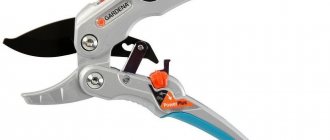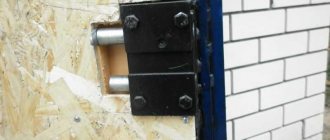By what principle is it better to choose a walk-behind tractor?
A walk-behind tractor is a mobile multifunctional power energy single-axle equipment based on a single-axle chassis. The second name, which was in use until 1980 in the USSR, is a small-sized pedestrian tractor .
On the territory of the Republic of Belarus there is a large selection of walk-behind tractors of any power, price range, design solution, color, brand, etc. A buyer who decides to buy a walking tractor invariably has questions: “So which unit should I choose for myself?” There are many options, starting from forums and searching for reviews on specific walk-behind tractors on the popular sites market.yandex.ru, onliner.by, or on the popular specialized resource askbeforebuy.ru, forumhause.ru
The second option is word of mouth (advice from a neighbor or relative). In life, after all, there will definitely be a neighbor who recently bought a walk-behind tractor and will tell you all the main points about operation. It works. Thus, entire villages buy one model in one store. The third option is to call our phone +37529 1831114, where the managers of our specialized motorcycle and cultivator store will be able to give you professional advice. Now let’s try to highlight the main points when choosing a walk-behind tractor in this article.
How to choose a walk-behind tractor for a summer house and garden.
Why do you need a cultivator?
Determine for yourself what exactly you need: a walk-behind tractor or a cultivator. In most cases, it is enough for users to purchase a heavy cultivator to perform certain work (cultivation, hilling, plowing). The cultivator is lighter and more maneuverable when used in a greenhouse. Also, if you have restrictions on physical activity, it is better to opt for high-quality medium cultivators.
The purpose of the walk-behind tractor
The walk-behind tractor is capable of performing a wider range of operations with the appropriate attachments: cultivation, hilling, plowing, transporting goods, mowing grass, snow removal, watering the garden, harvesting potatoes, etc. The design difference between a classic walk-behind tractor and a heavy cultivator is that the walk-behind tractor has a large mass (from 70 kg), is equipped with a more powerful engine (petrol or diesel) with a power of 4 hp, and often has a shaft or power take-off pulley (through which the drive goes to various mounted power equipment). So, if you decide that you need a cultivator, then we suggest that you read the article “how to choose a cultivator.” Otherwise, I suggest you familiarize yourself with the criteria for choosing walk-behind tractors. The first thing you should take a closer look at is the scope of work and the availability of the desired functions.
The scope of work will depend on three main parameters:
- The type of soil you will be working (soft, medium, heavy soil or virgin soil).
- Total processing area.
- Functions of the walk-behind tractor.
Soil type.
The main parameter here is the maximum torque and power of the engine . The second is the mass of equipment. If the walk-behind tractor does not have sufficient mass, then maximum traction with the ground will not be achieved and the walk-behind tractor will “slip” when working with a plow or hiller. The mass of the unit must be at least 70 kg for medium light soil, for heavy and virgin soil the mass must be at least 95 kg. A diesel “foot tractor” has more torque compared to a gasoline one (i.e. it has more traction). Negative aspects include difficulties with repairing diesel engines and seasonal restrictions on work (ambient temperatures not lower than + 2 degrees Celsius). All walk-behind tractors weighing up to 150 kg, when working on any hard soil with a plow, potato digger or hiller, must be equipped with metal wheels, hereinafter referred to as lugs.
Total processing area
The total processing area is determined based on the productivity of the unit. This value is quite arbitrary, as it depends on many factors: the type of soil hardness, the type of operation being performed (cultivation, hilling or plowing). There is a direct proportionality to the performance of the walk-behind tractor from the engine power and the processing width. So, conditionally, all walk-behind tractors can be divided according to the total processing area:
- Processing area up to 1500 m2 – device power from 3.5 to 4 hp. ,with processing width up to 800 mm. The Viking HB 685 walk-behind tractor has proven itself to be excellent in this segment (Figure 1).
- Processing area up to 3000 m2 - equipment power from 6 to 7 hp. with processing widths up to 900 mm. A huge number of choices among brands such as Neva MB 2B 6.5 PRO, Neva MB 2C-7.0 PRO, Fermer FM 700M, 701 pro.
- Processing area up to 1 hectare (10,000 m2) - powerful units with power from 9 to 10 hp. Neva MB 23B-10PRO, Fermer FM 901-905, FDE 1001, Belarus 0.9N.
Figure 1 - Lightweight unit with Viking HB 685 worm gearbox
You need to determine for yourself what functions you want to see in it, the walk-behind tractor. Here is a list of possible functions:
- Power take-off shaft (or power take-off pulley). The take-off shaft is designed for connecting various power equipment: rotary lawn mowers, rotary snow throwers, motor pumps, etc. Before purchasing, be sure to look at the possibility of connecting various attachments. For example, the Fermer FM 701 pro, 901-905 Pro walk-behind tractors do not provide for the installation of either a snow thrower or a lawn mower.
- Will you use it as a means of transportation, will you equip it with a trailer and what is the total weight. If you use a walk-behind tractor for these purposes, then opt for models with large pneumatic wheels Neva MB 23, Neva MB 2, Belarus 0.9N, Belarus 0.8MT, Fermer FM 902, FDE 1001.
- Will you use it as a snow blower in winter? If you want to use it as a snow blower, then choose models, firstly, with a gasoline branded engine (such engines always start the first time, even in extreme winter conditions. Secondly, look for those models for which installation is provided snow throwers: Neva MB 23, Neva MB 2, Belarus 0.9N (Figure 2), Belarus 0.9MT The drive to the snow throwers is carried out using a pulley or power take-off shaft.
- Will you use the walk-behind tractor as a lawn mower? The rotary lawn mower is driven by a pulley or power take-off shaft.
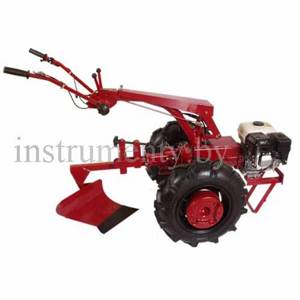
Figure 2-Belarus 09N weighing 176 kg with a Honda engine.
Now that we have decided on the scope of work and the availability of the desired functions, let's move on to the main structural elements of this device.
Which engine is better?
The walk-behind tractor engine is the very first and most important element that you should pay attention to. The cost of the engine ranges from 20 to 40% of the cost of the entire walk-behind tractor. The engine must be sufficiently durable, reliable and supported by after-sales service. You should choose among proven high-quality gasoline engines from such brands as Honda (GX-professional series), Subaru (professional series), Briggs & Stratton (semi-professional and professional series), Kohler (semi-professional series). Which is better to choose a gasoline or diesel ? This issue should be approached in two ways. A diesel engine has more torque, which means the walk-behind tractor will “pull” more. However, diesel engines cannot be used in winter. Also, a large number of requests come from users of motorized cultivators whose diesel engine has broken down and there is no possibility of repair. Indeed, repairing a diesel engine is quite an expensive and complex task compared to repairing a gasoline engine.
Weight.
As we already mentioned at the very beginning, for a walk-behind tractor one of the most important parameters is weight. If the walk-behind tractor does not have sufficient mass, then there will not be sufficient adhesion to the ground (friction forces) when working with a plow, hiller and potato digger. When operating equipment weighing up to 150 kg with a plow, hiller and potato digger, it is necessary to purchase metal wheel lugs. Also, the power units Neva (98 kg) and Viking HB 685 (weight 50 kg) provide the possibility of installing additional weights to increase the weight by 20-50 kg. The downside of excess weight is loss of maneuverability in the absence of a differential and difficulty in transportation. You should look for a middle ground (i.e. a walk-behind tractor in the range from 90 to 100 kg) with a differential and the ability to install additional weights when working on virgin soil. Examples of such walk-behind tractors are Neva MB 2 and Neva MB 23 (Figure 3)
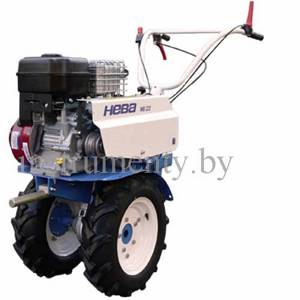
Figure 3-Neva MB-23B-10.0 pro with a semi-professional 10 hp engine.
Availability of differential.
The presence of a differential is a mandatory function for a walk-behind tractor. When purchasing a walk-behind tractor, buyers often strive to purchase equipment with high power, large wheels and impressive weight. However, after the purchase, they begin to look for options for modernizing the equipment and installing an axle separation mechanism. There are quite a lot of options for improving the differential for a walk-behind tractor described on the popular resource forumhause.ru. Many models are equipped with a differential: Neva MB 2 and MB 23, Belarus 09N, Belarus 08MT.
Walk-behind tractor transmission
The transmission of a walking tractor is a method of transmitting torque from the engine to the gearbox through various gearing options.
Options for transmission transmission from engine to gearbox:
- Belt (V-belt)
- Gear (gear transmission)
- Chain
- Chervyanoye.
You can read more about the advantages and disadvantages of all clutch options for walk-behind tractors in our article “Gearbox and transmission for walk-behind tractors”.
Gearbox.
A walk-behind tractor gearbox is a mechanism designed to convert torque, transmitted power, angular speeds and gear ratios from the engine to the consumed unit. Options for gearboxes on walk-behind tractors:
- Gear transmission (Gear)
- Gear-chain transmission. (gear-chain engagement)
- Worm-gear
The choice of gearbox should be approached quite carefully. The fact is that cheap walk-behind tractors often have non-separable gearbox. In the event of a breakdown, the entire assembly will have to be replaced. Also, gearboxes can be dismountable or non-dismountable. In addition, gearboxes can be serviced or maintenance-free . A serviced gearbox provides for oil replacement and checking, but a non-serviced gearbox does not. It is also necessary to pay attention to the material of the gearbox: aluminum and cast iron. In fact, the high-quality power units sold by our online store instrument.by are equipped with branded, serviceable, collapsible gearboxes. These gearboxes very rarely fail when properly used and maintained.
Processing width.
The processing width determines the performance of the walk-behind tractor. The greater the cultivation width of the walk-behind tractor, the fewer entries, maneuvers and turns you will need to make. However, here you should understand that the larger the cultivation width, the more engine power you need. The optimal cultivation width should be in the range from 700 to 1000 mm.
Processing depth.
By convention, manufacturers indicate the processing depth in the technical specifications. The depth of cultivation depends on 3 parameters: the diameter of the cutters, the weight of the walk-behind tractor and the hardness of the soil. The recommended cultivation depth should be between 200 and 300 mm.
Wheel size.
If you plan to transport cargo with a trailer, then you should take a closer look at models with large wheel diameters (from 450 mm). If you plan to use the walk-behind tractor only for agricultural machinery, then you should not pay special attention to the size of the wheels.
Adjustable handles.
Height adjustment of the handles is desirable for ease of use and transportation. It must be possible to rotate the handles 180 degrees.
Advantages and disadvantages of a diesel walk-behind tractor
Many walk-behind tractor manufacturers install diesel engines on their equipment, but the price increases significantly. Is this justified? To deal with this issue, you need to know all the advantages and weaknesses of such a unit.
A diesel walk-behind tractor has the following advantages :
- Gasoline engines produce very harmful emissions that are harmful to the environment. With diesel engines this problem is practically absent;
- Less fuel consumption. When compared, again, with a gasoline engine, a diesel engine consumes one fifth less fuel;
- The diesel engine weighs quite a lot, which makes the entire unit more stable and easily passable even in difficult areas;
- Traction is more increased;
- Torque is greater than gasoline;
- Such an engine will last many times longer than one that runs on gasoline.
There are, of course, disadvantages :
- Low maneuverability due to the impressive weight of the unit;
- High price. It is connected precisely with the cost of the engine, which is an order of magnitude more expensive than a gasoline engine;
- High vibration and noise during operation. Perhaps for some this is not even a problem, but there are people with hearing problems for whom increased noise is simply contraindicated;
- As you know, diesel fuel can freeze at low temperatures. But this problem can be solved by purchasing special fuel.
In addition, the diesel walk-behind tractor has impressive dimensions, which requires a lot of space for its storage. You can additionally buy attachments for it.
Manufacturers of walk-behind tractors.
Motoblocks Neva.
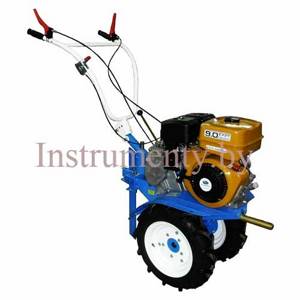
Figure 4 - Neva MB 23S-9 PRO with Subaru engine.
Neva walk-behind tractors are the most popular in Belarus. A distinctive feature is Russian assembly at the Krasny Oktyabr plant (St. Petersburg), the use of high-quality materials in production with state-of-the-art technology, and a reliable floating gearbox. All Neva walk-behind tractors sold in our store are equipped with a differential, professional and semi-professional Honda, Subaru, Briggs & Stratton engines, and also have quality certificates. Many years of production experience and high-quality service.
Models of Neva walk-behind tractors, which you can buy from us in the ChTSUP "Invita-Motors" store:
- Neva MB-2B 6.5 pro
- Neva MB-2C 7.0 pro
- NEVA MB-2C-7.5 PRO
- Neva MB-23B-8.0
- Neva MB 23S-9 PRO
- Neva MB-23N-9.0 PRO
- MB-23B-10.0 pro
The plot is about the Neva, which produces legendary units.
Motoblocks Belarus.
The MTZ 09 N walk-behind tractor is already a legend. High quality, thorough and reliable. These devices occupy leading positions among user ratings and reviews. The Belarus units have one drawback - their high price. You have to pay for quality.
Models of “pedestrian tractors” Belarus, which you can buy from us in the ChTSUP “Invita-Motors” store:
- Belarus 09H
- Belarus 08MT
Viking walk-behind tractors.
Branded walk-behind tractors from one of the world leaders in the production of garden equipment. Assembly takes place in Austria. The gearbox is worm, which significantly reduces dimensions and weight, while increasing service life. They are intended for small areas. It is recommended to immediately buy a set of attachments including weights and lugs.
Viking models, which you can buy from us in our company store.
- Viking HB 685
Chinese walk-behind tractors
As of 2013, almost all walk-behind tractors are produced or assembled in China. These can be either copies of Japanese, American, French walk-behind tractors, or their own brands. However, there are global manufacturers that supply high-quality walk-behind tractors to many countries around the world, and there are low-quality ones, the assembly and service of which is questionable. It is for this reason that the basis for the selection of walk-behind tractors sold in our store was the quality of service and the manufacturer.
Chinese Farmer walk-behind tractors.
Fermer walk-behind tractors burst onto the Belarusian market in 2010. High-quality assembly from one of the world's recognized manufacturers in China. Advantages: high quality, low price, constant modernization of models and availability of spare parts. The optimal solution when purchasing a Chinese unit.
Models of Fermer walk-behind tractors that you can buy from us on the website instrumenty.by
- Farmer FM-701 PRO
- Farmer FM-700 M
- Farmer FM-901 PRO
- Farmer FM-902 M
- Farmer FM-902MS
- Farmer FM 902 PRO-S
- Farmer FM 902 PRO
- Farmer FDE-905 PRO
- Farmer FD-905 PRO
- Farmer FDE-1001 PRO
Mechanical engineer, Dmitry Buto
How to understand the variety of walk-behind tractors
To make an informed purchase, you need to consider:
- if your tasks are not limited to cultivating the soil, then you should prefer a full-fledged walk-behind tractor to a cultivator: it is much more versatile and will make your daily work on the site much easier;
- Diesel walk-behind tractors are more expensive than gasoline ones, but are justified by their economical use;
- when calculating the power of the equipment, take into account the area of your site and the nature of the soil;
- pay attention to the complete set of walk-behind tractors and check the price of tracks for a walk-behind tractor and other accessories at the purchase stage: most of the functionality depends on additional equipment, and without knowing its cost it is impossible to plan a budget;
- many devices can be made independently: there are many drawings of a potato digger for a walk-behind tractor with your own hands or a video of a snowmobile made from a walk-behind tractor with your own hands;
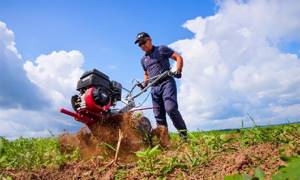
Walk-behind tractor with functional transmission
- The manufacturer plays an important role. Japanese equipment is of higher quality and more expensive, but it makes sense to choose it if large financial investments are justified. Chinese models are the cheapest, but often their quality leaves much to be desired, since the low cost is explained by savings on materials;
- products of domestic brands cannot boast of an impeccable Japanese reputation, however, many modern models are worthy competitors in terms of quality. Moreover, more and more companies use imported parts, for example, Subaru engines for walk-behind tractors.
Thus, choosing a worthy model requires careful comparison of options and preliminary calculations. But the result is worth the effort, because in the form of a walk-behind tractor you will acquire an indispensable assistant on the site.
What is a walk-behind tractor
The name of this type of technology speaks for itself. The mechanized unit operates on the basis of an engine, which can be gasoline or diesel. The gearbox shaft is supplemented with a right and left motor - attachments are attached to it, which is responsible for expanding the functionality of the device.
Wheels with powerful tires are responsible for moving the walk-behind tractor. Adhered dirt is independently cleared from the wheels while moving on the ground, provided that they are installed correctly based on the direction of their rotation. You can find out how to install the wheels from the instructions for the walk-behind tractor.

The walk-behind tractor engine can be gasoline or diesel
A special lever is provided to adjust the lift height and steering angle. The battery is a non-removable self-charging battery.
Types and prices of walk-behind tractors and attachments for them
The functionality of a walk-behind tractor depends on the number of attachments, because they are responsible for performing various tasks. Such devices can be included in the basic equipment package or purchased separately.
Of course, the more versatile and functional the device, the higher its price, so it is advisable to initially decide what additions to the walk-behind tractor you need right away, and then purchase additional elements as necessary.

Functional unit for different types of site treatment
You can make many details yourself, for example, you can easily find drawings and videos of potato planters for a walk-behind tractor with your own hands. Or you can modify the device by making snowmobiles from walk-behind tractors with your own hands. So, you will save money and get equipment that perfectly suits your needs, because independent work is more profitable than the prices of snowmobile attachments for walk-behind tractors.
The following main types of attachments exist:
- mowers: they can be mounted, frontal or rotary; they are used to mow tops, care for the lawn and make hay. You can make a mower for a walk-behind tractor with your own hands or buy a factory model for 8,500 rubles or more;
- hillers: there are paired, single, disk, ploughshares. They are used to hill up plants and loosen the soil between rows to remove weeds. The price starts at 400 rubles;
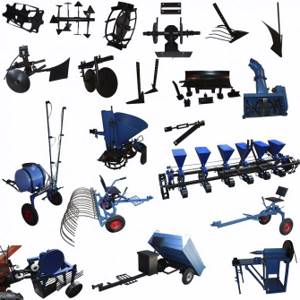
Attachments for walk-behind tractors
- cultivators: used for cultivating land and can also be used for harrowing the fertile soil layer. The cost of the factory model is about 3,500 rubles, although you can make a special attachment using a video harrow for a walk-behind tractor with your own hands;
- riding module: if it is necessary to process large areas of the site, such a module allows a person to sit. The cost of a plowing and riding cart starts from 10,300 rubles;
- trailer: used for transporting goods, can be regular or have a tipping body. You can do it yourself; drawings of trailers for walk-behind tractors are not difficult to find on the Internet. You can buy the product in the store for 13,700 rubles. and higher.

Walk-behind tractor with trailer for transporting crops
Manufacturers and estimated prices
Having gained an idea of the technical parameters and capabilities of these units, it is much easier to answer the question of which walk-behind tractor is better to buy. In this case, we can only compare prices in the selected class of these cars.
In the category of light and medium-sized gasoline walk-behind tractors, equipment from domestic and foreign companies competes almost equally.
Among light walk-behind tractors, the Russian brand Salyut is in demand today. Users of this equipment write in their reviews that the best walk-behind tractor from this company is the one with a 4-stroke Japanese gasoline engine with a power of 5 hp, a gear reducer and a V-belt clutch. Its price starts from 31 thousand rubles.
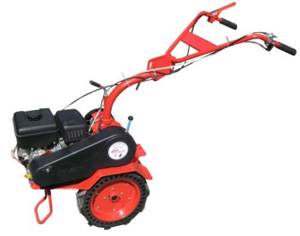
Its competitor, the Neva MB 3C walk-behind tractor (weight 70 kg), is equipped with a 5.7 hp Subaru engine. At a cost of 34 thousand rubles. This unit is optimal for working on personal plots and farm plots.
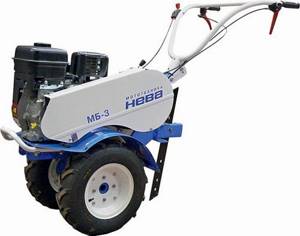
The cost of medium-sized walk-behind tractors from the French brand Caiman starts at 46 thousand rubles. This is the amount you will have to pay for a 6-horsepower unit with a Robin-Subaru engine. It is equipped with 2 forward and one reverse gears. Its maximum tillage depth is 32 cm with a working width of up to 90 cm.
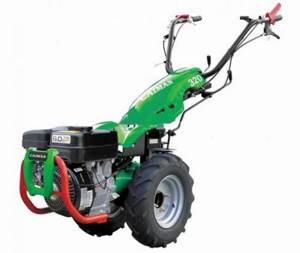
Motoblock Cayman
Domestic medium-sized walk-behind tractors Neva and Cascade with the same performance characteristics and reliable American Briqqs & Stratton engines will cost a more modest amount - from 34 to 39 thousand rubles. The price tag for a Chinese gasoline Centaur (7 hp), capable of plowing the soil to a depth of 30 cm with a passage width of 100 cm, does not exceed 26 thousand rubles.
In the category of heavy diesel walk-behind tractors, in terms of price-quality ratio, the Scout equipment is a confident middle peasant. Walk-behind tractors with a rototiller from this manufacturer with a capacity of 8 liters. With. (such as 81 D) can be purchased from 59 thousand rubles, more powerful models (101 DE, 15 DE) will cost about 80-85 thousand rubles.
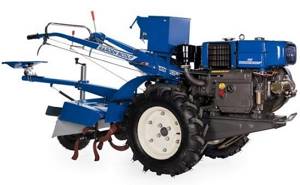
Scout 15 DE
You should also pay attention to the MTZ Belarus brand and the Chinese Zubr. These machines are equipped with Honda and Briqqs&Stratton diesel engines with a power of 9-10 hp, have a disc clutch and a gear reducer
Four forward and two reverse speeds allow you not only to efficiently plow heavy soil, but also to transport loads on a trailed trolley. The price of such walk-behind tractors starts at 70 thousand rubles.
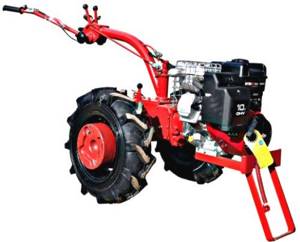
Motoblock MTZ Belarus
In reviews of heavy Zubr walk-behind tractors, one can find complaints about low quality workmanship, the need to tighten connections before use, and noise during operation. This unit is inferior to the MTZ brand, but at the same time is much cheaper than its Belarusian counterpart (the price of a 12 hp unit is in the range of 42-46 thousand rubles)

Heavy walk-behind tractor Zubr
The best light walk-behind tractors with an engine power of 4.5 - 6 liters. With.
Walk-behind tractors of this class are lightweight gardening equipment capable of loosening and cultivating already cultivated soil. The potential of such devices does not allow plowing large areas, but they can cope with an area of 6–10 acres of regularly cultivated land.
| Masteryard QUATRO JUNIOR DIESEL TWK+ | Caiman VARIO 60S TWK+ | Champion DC1163E | |
| Power, hp | 5,5 | 6 | 5,8 |
| Plowing depth, cm | 32 | 32 | 30 |
| Weight, kg | 84 | 72 | 141 |
| Plowing width, cm | 30-90 | 30-90 | 80-110 |
| Electric start |
Masteryard QUATRO JUNIOR DIESEL TWK+
The power of the walk-behind tractor is 5.5 horsepower, and the working width, depending on the settings, is adjustable from 30 to 60 cm. The depth of cutter penetration into the soil is 32 cm, but this indicator can also be adjusted. Model weight 84 kg.
+ Pros of Masteryard QUATRO JUNIOR DIESEL TWK+
- The model is equipped with an engine with a filtration system and forced air cooling.
- A waterproof, reinforced Japanese-made chain gearbox allows this unit to work perfectly under extreme loads and ensure minimal power loss.
- Pneumatic wheels with large rubber tread allow you to work on any terrain.
- The presence of reverse ensures reverse gear when turning and hitting an obstacle.
- Two speed modes.
- For ease of transportation there is a small transport wheel.
– Cons of Masteryard QUATRO JUNIOR DIESEL TWK+
- Before the first start, the oil level must be replenished.
- Soil cultivation area 3000 sq. meters.
Conclusion. Masteryard QUATRO JUNIOR DIESEL TWK+ has virtually no negative reviews from both ordinary customers and professionals. This is an excellent option for small private farms where there is a need for good plowing and cultivation. Low fuel consumption minimizes costs and reduces payback periods.
Caiman VARIO 60S TWK+
A light-duty walk-behind tractor with the ability to process areas up to 2500 sq. m. meters. The walk-behind tractor is equipped with a four-stroke gasoline engine with a volume of 169 cm³, l. With. The diameter of the cutters is 32 cm, which are capable of entering the soil to a depth of up to 32 cm. The processing width ranges from 30 to 90 cm, depending on the settings.
+ Pros of the Caiman VARIO 60S TWK+
- The power take-off shaft allows for many additional functions.
- Chain gear with two forward gears and one reverse.
- High maneuverability and light weight.
- High-quality cultivation cutters work with any type of soil.
- The upper position of the valves on the engine guarantees reliable and trouble-free operation.
- Availability of innovative patented VarioAutomat transmission.
– Cons of Caiman VARIO 60S TWK+
- High cost compared to walk-behind tractors in this class.
- Very noisy.
- Chain gear parts require replacement during constant use.
- Small fuel tank of 3.4 liters.
Conclusion. One of the most expensive in its class. However, the expression “the price justifies the quality” is right for him - this is a reliable and productive walk-behind tractor that will serve for many years. The ability to install additional attachments on it makes it a multifunctional assistant.
Champion DC1163E
Powerful and productive walk-behind tractor with a single-cylinder four-stroke engine with electric and manual start. The electric starting device is powered by a battery. The Champion DC1163E runs on diesel fuel and weighs 141 kg. The cultivation width is 110 cm, and the cultivation depth is 30 cm. The power of the unit is 5.8 hp. which allows you to reach speeds during transportation: in first gear up to 5 km/h, and in second gear up to 10 km/h.
+ Pros Champion DC1163E
- Large fenders for safe operation and protection from dirt.
- Possibility of use for transporting goods up to 450 kg.
- Adjustable control panel.
- Good maneuverability thanks to reverse.
- Large processing width.
- Acceptable price.
- Low fuel consumption.
– Cons of Champion DC1163E
- Large weight - it is better for trained and experienced users to operate such a device.
- No downshifts or unlockers.
- Problematic assembly and preparation for the first launch.
- Compared to the impressive weight, the power of the unit is low.
Conclusion. Champion DC1163E is a truly universal device that performs not only plowing, but also loosening, harrowing and transporting goods. When purchasing special attachments, this machine becomes a multifunctional piece of equipment with a long service life and good performance.
The best light-duty motor cultivator
Huter MK-7000
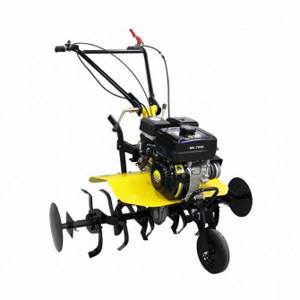
Main parameters of the model:
- adjustable working width (640-1000 mm);
- soil working depth 300 mm;
- protection against low oil level;
- selection of the optimal speed mode;
- simple disassembly/assembly, which allows you to quickly get the device into working condition;
- number of cutters included - 6;
- number of gears - 1 forward, 2 reverse;
- reverse - available.
Advantages:
- good plowing width;
- maneuverability (3 speed modes);
- safety;
- optimal power.
Disadvantages: none.
Caiman VARIO 60S TWK+

A model from French manufacturers, equipped with a reliable gasoline power unit from Japan. The equipment belongs to the light category, its weight is 72 kg. The engine is 4-stroke, with 1 cylinder, there is air protection against overheating. Power 6 l. s., volume 169 cm3. To start the engine, a manual starter is used; it is possible to switch to electric starting.
Model Specifics:
- handles adjustable in 3 planes, which allows the operator to work with maximum comfort;
- steel motor protection from mechanical influences and contamination;
- smooth transition between speeds due to the Vario Automat transmission;
- presence of reverse;
- good maneuverability. The special structure of the steering columns allows for 180-degree turns. There is also the possibility of unfolding on one wheel;
- low center of gravity, which gives the model special stability;
- drive type - chain;
- fuel tank capacity 3.4 l;
- noise level 95 dB.
The cultivator is designed to cultivate an area of up to 2.5 thousand m2. The working width varies from 300 to 900 mm, cultivation depth is 320 mm. The set includes 6 cutters.
Advantages:
- ease of use;
- good quality of soil treatment;
- reliable Japanese-made engine;
- quality cutters.
Minuses:
- high price of a branded drive belt;
- The speed switch is stuck.
Weima WM500
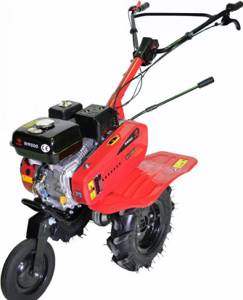
Lightweight and very ergonomic motor cultivator. The model is distinguished by its ease of maintenance and a structure thought out to the smallest detail. For greater convenience of working with the unit, the working width can be changed from 500 to 1000 mm. The depth of plowing is 300 mm. The ability to use additional attachments allows you to solve other problems: hilling sprouts, mowing grass, etc.
The cultivator is equipped with a 6.5-horsepower motor with a rotation speed of 3600 rpm. The gearbox is mechanical, the type of clutch is belt. There are 3 speed modes: 2 forward, 1 reverse. Fuel tank capacity 3.6 l. Unit weight 74 kg. A filter that purifies the air entering the combustion chamber helps to extend the working life of the power unit. Pneumatic wheels ensure good maneuverability of the device.
CHAMPION EC1400

The only model in our rating from the famous manufacturer CHAMPION with an electric motor. A lightweight and relatively inexpensive corded cultivator equipped with a 1.4 kW electric motor. This is enough to transmit torque to 6 cutters. The motor has double winding insulation and is reliably protected from overheating and power surges. The plowing width is 400 mm, the depth is 210 mm. Moreover, the weight of the device is only 11 kg. Power source - AC mains (230 V).
Transport wheels make it easy to move the unit around the area. The handles are removable and can be easily secured using wing joints. This feature allows you to compactly store the cultivator.
Advantages:
- powerful motor;
- small weight;
- optimal working width and processing depth;
- environmental friendliness, no air pollution from harmful exhausts;
- protection against power surges in the network;
- low noise level;
- steel worm gearbox;
- handle fixed at 4 points;
- minimal vibration.
In addition to the equipment itself, the kit includes 6 working cutters, a 2-part handle, transport wheels and a wing that protects the operator from clods of earth, and the body from contamination.
